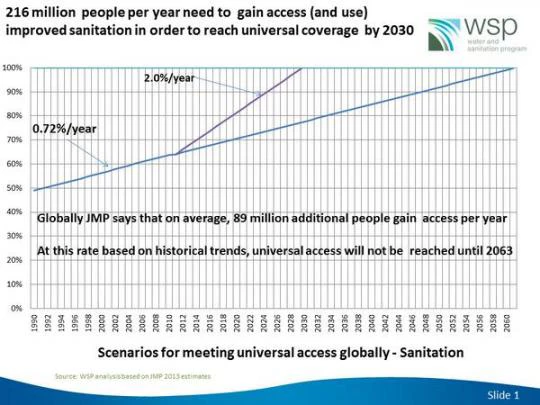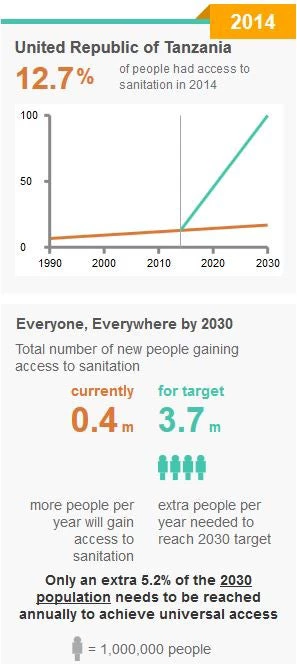The proposed WHO/UNICEF Joint Monitoring Program (JMP) WASH Post 2015 goals for sanitation calls for universal access to basic improved sanitation – by the year 2030. Using largely small scale project approaches that have failed to deliver sustainable sanitation service delivery – especially for the poor -- most countries have not yet achieved the more modest MDG sanitation goals. However, many countries have already started working to achieve the goal of universal access by taking steps to make the transformational changes needed to stop doing “business as usual” in their sanitation programs.
At the recent High Level Meeting of the Sanitation and Water for All (SWA) partnership – attended by 20 ministers of finance and 35 ministers responsible for water and sanitation representing 43 countries -- over half of the countries set out a vision to achieve universal access to sanitation by or before 2030, 22 countries aim to eliminate open defecation by or before 2030 and, two-thirds of the countries made specific commitments relating to the elimination of inequalities. Countries such as Tanzania, Kenya, Laos, India, Ethiopia and Indonesia are making changes in policies, institutional roles, financing approaches, programmatic approaches, and strengthening the implementation capacity of local governments. Providing access to basic sanitation for everyone is a daunting challenge. Universal access using "business as usual" approaches will not be achieved until about 2063. In order to reach universal access globally by 2030, the global community will need to increase access by about 2% per year
resulting in 216 million additional people a year gaining (and using) access to basic improved sanitation.
Providing access to basic sanitation for everyone is a daunting challenge. Universal access using "business as usual" approaches will not be achieved until about 2063. In order to reach universal access globally by 2030, the global community will need to increase access by about 2% per year
resulting in 216 million additional people a year gaining (and using) access to basic improved sanitation.

Visit the interactive map to view
sanitation access by country.
(Note: You will need to switch
the indicator located below the map
from "water" to "sanitation")
So what are countries doing? Building on evidence from at-scale pilots that serve as policy learning laboratories, governments are establishing a shared vision and strategy for rural sanitation among key government and development partner stakeholders and are creating high level political will at national and regional levels. Governments are developing rural sanitation policies that define a set of procedures, rules, and allocation mechanisms to provide the basis for a national rural sanitation program. Increasingly, these policies are being reflected in laws and regulations, economic incentives, and the assignment of rights and responsibilities for a rural sanitation program implementation. Governments are partnering with the private sector to increase the availability of sanitation products and services that respond to consumer preferences and their willingness and ability to pay for them and are also working to improve the adequacy of arrangements for financing the programmatic costs. Governments are also strengthening their capacity to track implementation and results to be able to make adjustments in a national rural sanitation program.
Success with Sanitation Business in Indonesia
Indonesia is a good example. The operational guideline for the Community-Led Total Sanitation Strategy (STBM) was legalized this year under a Minister of Health Regulation. The guideline provides the necessary operational details for the MoH Decree on the STBM strategy issued in 2008. Strategic plan/polices to implement the shared vision were formalized as the national approach by Government and subsequently adopted by key development partner projects (including the World Bank). The MoH has accredited the curriculum and modules for community-led total sanitation (CLTS) and sanitation marketing. To ensure quality of training, successful participants are awarded 1 credit point which counts towards their performance as part of the staff and career performance assessment.
In Tanzania, one of the key interventions through which the government of Tanzania is expected to achieve its sanitation vision and targets is the National Sanitation Campaign (NSC). The Ministry of Health and Social Welfare coordinates the implementation of the National Sanitation Campaign with funding from the Water Sector Development Program. There have also been efforts to further strengthen and sustain the NSC structure by establishing linkages to other sectors experts and also getting the Ministry of Health to dedicate a budget line for community sanitation. The Water Basket is the main financing mechanism for community sanitation and hygiene in Tanzania. In the Water Basket, there is a clear budget line for sanitation.
In Kenya, following the April 2013 elections the country moved to a devolved system of Government in line with a new constitution which meant that the new structure of 47 counties became responsible for sanitation. Sanitation marketing is being included in the revised national policy and strategy to build on existing CLTS strategies, and a national improved sanitation campaign has been developed and launched. Based on formative research new products have been designed which meet consumer preferences as well as being affordable. Two private sector plastics manufacturers have launched a new range of plastic sanitation slabs. Some counties have found innovative ways to fund sanitation e.g. through money collected from environmental health licenses and fines and have been able to significantly increase the allocation of their budget for sanitation than in previous years.
There are an increasing number of countries that are making similar transformational changes. Collectively, these changes are beginning to “bend the arc of history” of failed services delivery and emerging national level rural sanitation service delivery programs have started to significantly increase the rate of increase in sanitation access for rural households and reach universal access for all families living in rural areas.


Join the Conversation